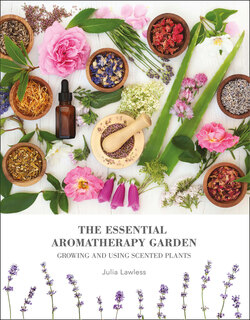Читать книгу The Essential Aromatherapy Garden - Julia Lawless - Страница 9
ОглавлениеEARLY AROMATIC GARDENS
Some of the most famous early aromatic gardens are the Hanging Gardens of Babylon, which were built by Nebuchadnezzar II for his wife in the sixth century BC. Greek descriptions of these fabulous gardens, which were supported on stone columns and irrigated by streams to keep the terraces moist, depict an image of paradise much like the Persian ideal, with running water, shade and scent. Aromatic wood from the cedar of Lebanon was used extensively in building these gardens and must have created a highly fragrant backdrop for the exotic flowering plants, herbs and trees.
Cedar of Lebanon was also used to make the caskets for embalmed Egyptian kings because of its fine fragrance and great durability. Indeed, the ancient Egyptians were renowned for their knowledge and expertise on aromatic plants, especially regarding their medicinal, cosmetic and ritual applications. In gardens on the banks of the Nile, they cultivated sweet-smelling plants, herbs and spices so as to provide fresh material for their daily requirements, since natural aromatic preparations were considered an intrinsic part of everyday life. One of the first depicted plant expeditions (c. 1495 BC), shown in a wall painting at Karnak, is in search of the incense tree for Queen Hatshepsut. The Egyptians’ exuberant love of nature is evident from the carvings in their temples and their garlanded deities. No fewer than 256 different species are depicted on the walls of the ‘Botanical Garden’, a room in the temple of Amun at Karnak.
Saffron crocus (Crocus sativus), used by the ancient Egyptians as a condiment and perfume material.
Valentina Razumova
Henna flower (Lawsonia inermis), used to make the ancient Egyptian perfume ‘cyprinum’.
Swapan Photography
The Egyptian priesthood also attached great importance to gardens as places of contemplation. Thus we find walled gardens attached to the temples as tranquil places of retreat. More importantly perhaps in botanic terms, was the fact that known medicinal plants were grown in these temple gardens, and form the earliest-known basis for the botanic garden. The Egyptian Papyrus Ebers manuscript, a materia medica written about 1552 BC (in the time of Moses), contains numerous descriptions of fragrant plants, aromatic remedies and their methods of use. Saffron was employed as a condiment and perfume material; galbanum, mastic and eaglewood were used for fumigation and purification purposes; and cannabis or Indian hemp was used as a sedative and for its narcotic properties. The scented oil from the blue lotus was considered sacred and offered to the pharaohs in their tombs along with narcissi and other aromatic materials. Frankincense and myrrh, especially, were considered invaluable plants throughout the whole of the ancient world, because their fragrant gum-resins formed the basis for most incense. The famous kyphi of Egypt, for example, was a liquid incense recipe whose fragrance, according to Plutarch, ‘allayed anxieties and brightened dreams and was made of those things which delight most in the night.’ This precious perfume was made from a mixture of over 16 aromatic substances including juniper, cardamom, calamus, cyperus (a fragrant grass), mastic, saffron, acacia, cinnamon, peppermint, myrrh and henna.
In Cairo, street sellers sang of henna, ‘Oh odours of Paradise: oh flowers of Henna’: these were tiny white, very fragrant flowers which were also used to produce the enticing perfume ‘cyprinum’. Cleopatra drenched her Nile barge with cyprinum to create an aromatic greeting for Mark Anthony. Henna is also the ‘camphire’ mentioned in the Song of Solomon:
A garden enclosed is my sister, my spouse; a spring shut up, a fountain sealed. Thy plants are an orchard of pomegranates with pleasant fruits: camphire and spikenard, saffron, calamus and cinnamon, with trees of frankincense, myrrh and aloes with all the chief spices.
(Rosemary Verey, The Scented Garden)
The enclosed scented garden described in the Bible in the Song of Solomon depicts a sensual paradise where sacred and secular pleasure are united, and provides a model for the medieval ‘hortus conclusus’. Likewise, the Garden of Eden originally showed God and man in a state of complete harmony: in the Talmud, when Adam walked in the Garden of Eden on the first day, ‘he smelled wonderful scents and enjoyed beautiful sights’. But this sense of blissful ease was not to last, for both Judaism and Christianity refer back to the Garden as a place of original ease, a lost paradise, where humanity and nature were in accord with the divine, God.
In the beginning, God created a garden called Eden. Eden is traditionally located in Mesopotamia, probably in the northern part of the region since an apple tree was able to grow there without irrigation. Before the fall, Eden was a fertile, fragrant oasis of delight, magically calm except for the sweet sounds of water and laughter. Since the dawn of civilisation, human kind has ceaselessly endeavoured to recreate this mythical paradise.
(G. Van Zuylen, Visions of Paradise)
This is doubtless the root of our search to create an arcadian paradise over the centuries: an attempt to recreate a sense of perfect harmony. This is even more relevant today when the pressure and problems facing both the individual and society at large seem to be increasing. The Prince of Wales finds his garden at Highgrove in Gloucestershire:
… a place of escape from the noise, rush and often the brutality of the world. It is a place where both humans and wildlife can take sanctuary. The garden in this way can become a glimpse of Paradise; a sacred space where humanity, nature and the Divine meet in harmony.
(Martin Palmer and David Manning, Sacred Gardens)
Blue lotus (Nymphaea caerulea), considered sacred by the ancient Egyptians.
photo-oasis
